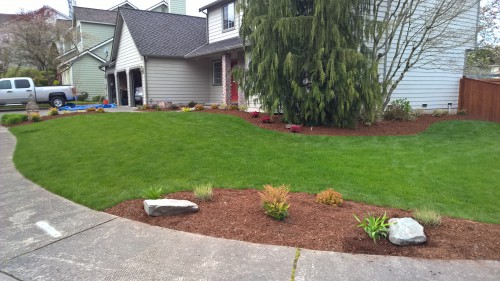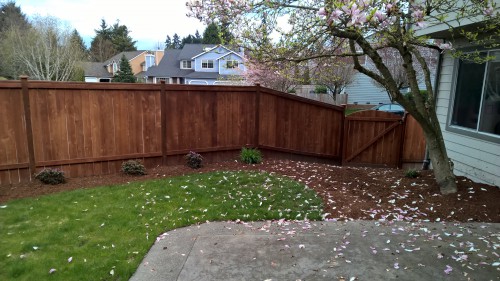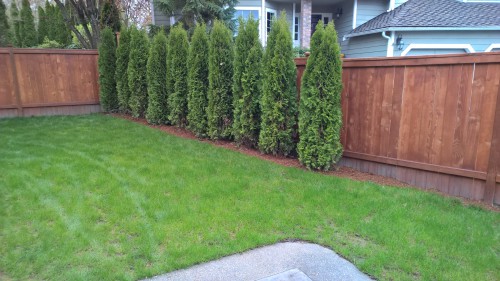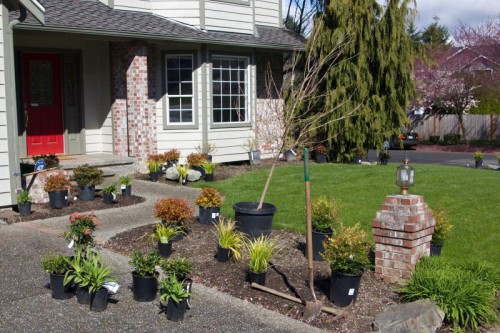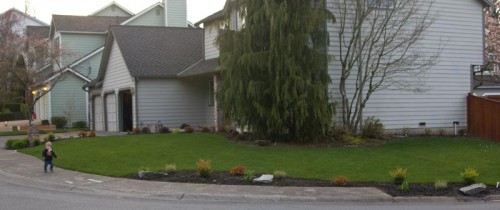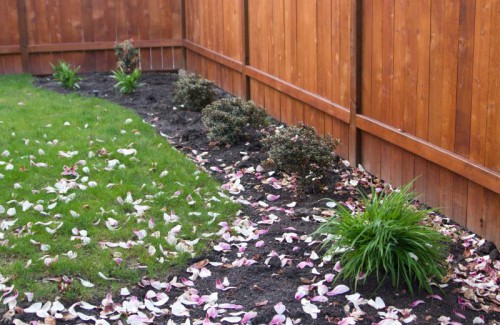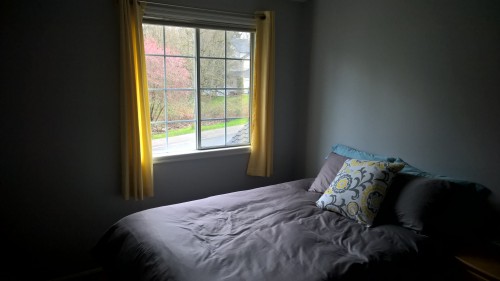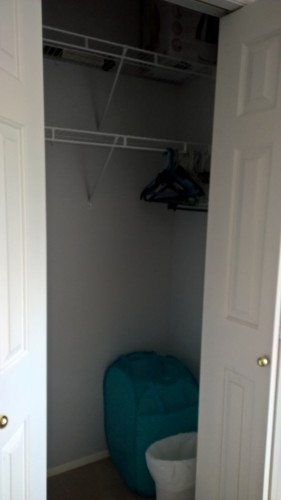Last weekend I spread seven cubic yards of bark around my house. Thanks to Logan for helping! It took a lot of wheelbarrow loads, but it looks great now. The bark lays nicely over the drip irrigation that I put in place (under Tim’s tutelage) to water each plant. It will help hold in the moisture from the drip irrigation, and, in conjunction with the pre-emergent I put down, it should keep weeds from growing. And oh yeah, it looks really nice too!
Plants
The final step in the back yard and front yard makeover was putting in new plants. We held off last year to spread out the bills and because I was more comfortable installing the new plants at the beginning of the growing season.
Picking plants for the entire yard would normally be a pretty daunting task, but it only took Tim a couple hours to figure out what would look good and walk me through it. He showed up with all the plants and we got them planted in less than three hours. Thank you (again) Tim!
The grass in the back yard heading down to the gate under the magnolia tree never had a chance. The constant wet weather in the winter left a steady stream of water flowing down an area that rarely got sun and it just turned to mud. I gave up on that and decided to bark it over as a walkway down to the gate. I also took the opportunity to make a planter along the fence out to the corner to add a little life to the back yard. You can see that new planter area in the last picture. We had planned ahead for this possibility and there was a drip line stubbed out in the corner.
This week I’ve been working on finishing off the drip irrigation lines and then this weekend I’ll be putting down six yards of bark over the top of all the planter areas. It will look nice and help slow down the weeds.
Guest Room Makeover
We have four bedrooms in this house so two of them were relatively unused. One was Tyla’s craft room/workout room and the other was the guest room. We decided to flip flop the rooms and while we were doing that, we might as well paint it. Those are two of the last rooms in the house that have original paint on them (one other is the formal dining room.)
Tyla did a bunch of research and came up with a color scheme. I did the grunt work of painting the room, painting the door (it was a weird off white color), and installing shelving in the closet. And then Tyla got the room all put together. Teamwork! We finished the project pretty quickly by working in the evenings after Elijah went to bed and it was done in time for my parents when they came to visit.
I’ll skip the before pictures since they basically just show white walls, no curtains, and no shelves. Here’s what it looks like now!
This project is done enough for now but we have lots more that we would like to do. The room could use a mirror and some wall hangings. I also want to build a nightstand, a dresser and maybe even a bed. This would be a good room for me to practice my woodworking skills since it’s not generally in use and we can get by with it the way it is now.
DIY Window Screens
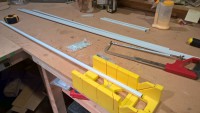 We’ve never had a screen on the window in the master bathroom. At first it wasn’t a big issue since we never open that window, but when I have to seal the grout, it’s nice to be able to open the window. And with a big tree right outside, I always have visions of a squirrel or a bird making its way inside.
We’ve never had a screen on the window in the master bathroom. At first it wasn’t a big issue since we never open that window, but when I have to seal the grout, it’s nice to be able to open the window. And with a big tree right outside, I always have visions of a squirrel or a bird making its way inside.
So I headed to Home Depot and bought the stuff to make a screen. Then I returned it and bought it again. Did you know that there are two different thicknesses for the screen frame? I didn’t, but now I do. As I was building the frame, it dawned on me that this is an easy home repair that some homeowners might not know how to do.
You can find plenty of YouTube videos to show you how it works, but here are the basic pieces. There is a metal frame that consists of four pieces cut squarely and held together with plastic corners. The plastic pieces slide tightly into the tubes and make a pretty strong joint. Some springs also slide onto the frame on one side. Then there is a groove that goes along the outside of the frame. Screen material is unrolled over the frame and then a thin piece of rubber gets jammed down into that groove and it stretches the screen material tight. Save yourself some grief and just buy the littler roller tool to help push the rubber into the groove. Finally you cut off the excess screen material and voila!
I redid every one of the screens in our house back in 2012 since the previous ones had all been torn up by cats. Now that I’ve built this one for the bathroom, I’m hopefully done for a while. It’s a handy skill to have in your bag of tricks though because it’s pretty easy for the screens to get damaged. Repairing them yourself is way cheaper than paying someone else to do it.
Summer Plans
 I feel like I missed last summer even though I spent more time outside than I have in a long time. Nearly every evening for two months was spent outside with Tim working for 4-5 hours in the evenings on the front and back yards.
I feel like I missed last summer even though I spent more time outside than I have in a long time. Nearly every evening for two months was spent outside with Tim working for 4-5 hours in the evenings on the front and back yards.
So what’s on tap for this summer? What monster house project will I tackle? NOTHING. We’re specifically saying no big projects this summer. We want to leave our time free to enjoy the weekends and get outside as a family.
But home improvement is kind of a hobby I guess, so there will be some smaller projects. For example, I’ve got an endless list of woodworking project ideas, and there will be a day coming soon when Tim and I will put plants all around the house. I bought a basketball pole that needs to be installed and Tyla wants a desk in her craft room. So I’ll still have projects to do but nothing will be so important that I have to put it before normal fun summer activities.
We’ve been getting lucky the past couple months with temps well-above normal. I’m sure we’ll be in for more cool, rainy weather, but these past couple weeks have given me a strong case of spring fever. The grass is growing, the cherry and magnolia trees are blooming. Bring on the summer of nothing!
Wall Mount
Lots of kids are injured every year from falling TVs. The number is increasing rapidly as people have moved from big heavy CRTs to light LCD TVs. The best number I could find was 12,000/year back in 2011. That’s not a huge number. There are plenty of riskier things to worry about first, but wall mounting the TV is something I’ve wanted to do anyway so this was a good excuse.
I picked up one of the more popular models from Monoprice for only $37. And I know some of you are content to leave your cables dangling down the walls, but that would drive me nuts in my own house. Running them through the wall is pretty simple with a kit like this for $40 from Amazon. It complies with code by splitting the box for the power and the low voltage cables.
Installation was pretty quick and simple: find two studs, drill the holes, and attach the mount to the wall. The laser level was a big help for this. That’s a paper bag you see taped to the wall to catch some of the dust.
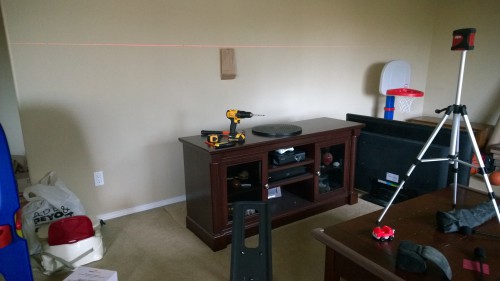 Next I used the included templates to trace out the holes for the power extension kit and cut holes in the drywall. Yes, I could have just added a new outlet here, but doing it this way means that I can connect this outlet to my battery backup and add some extra protection for the TV.
Next I used the included templates to trace out the holes for the power extension kit and cut holes in the drywall. Yes, I could have just added a new outlet here, but doing it this way means that I can connect this outlet to my battery backup and add some extra protection for the TV.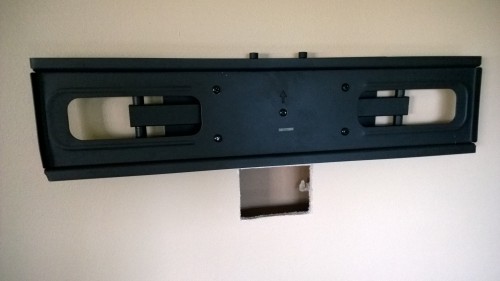 The final step was attaching the mounting brackets to the back of the TV, removing the old base, and then hanging it on the wall. The mount pulls out pretty far from the wall so that the TV can swivel 90 degrees in each direction (nice if we are watching from the kitchen), and it also tilts in the other two directions. My mount is really level, but the 5 degrees of tilt would help you correct most mistakes.
The final step was attaching the mounting brackets to the back of the TV, removing the old base, and then hanging it on the wall. The mount pulls out pretty far from the wall so that the TV can swivel 90 degrees in each direction (nice if we are watching from the kitchen), and it also tilts in the other two directions. My mount is really level, but the 5 degrees of tilt would help you correct most mistakes.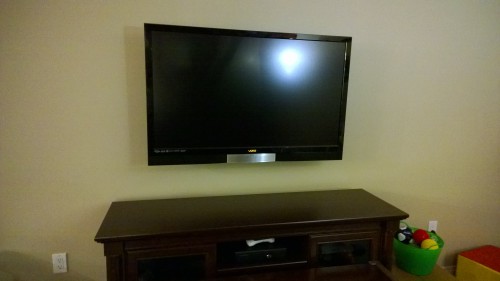 I’m very happy with how this all turned out. It was pretty cheap and only took about 2 hours to finish. If you’re comfortable wiring an outlet and operating a drill, this is something you can accomplish. Just make sure you’re in the center of those studs! I used a stud finder and then pounded a small nail in multiple times across the entire face of the stud to find both edges. It’s all covered by the mount anyway so the extra holes don’t matter (and they are easily patched if needed.)
I’m very happy with how this all turned out. It was pretty cheap and only took about 2 hours to finish. If you’re comfortable wiring an outlet and operating a drill, this is something you can accomplish. Just make sure you’re in the center of those studs! I used a stud finder and then pounded a small nail in multiple times across the entire face of the stud to find both edges. It’s all covered by the mount anyway so the extra holes don’t matter (and they are easily patched if needed.)
I’m still debating if this is a little too high. There’s plenty of adjustment in the mount that screws to the back of the TV so I might lower it just a bit.
Fixing Christmas Lights
When I finally decided on Christmas lights last fall, I decided to go with the professional grade wires, sockets and bulbs so that I could have the bulbs be interchangeable. That worked well and allowed me to do alternating red and soft-white C9 bulbs. It looked great except for one bulb that didn’t work. Testing it with the multimeter showed that the socket itself was bad. With a normal set of lights, I’d either have to live with it or pay another ~$40 for another 100ft strand of wire with sockets. But what I bought was repairable! (Pro tip: put some tape on your strand to mark both ends and any of the dead sockets. It’s a lot easier to find them when you have it all balled up on your workbench.)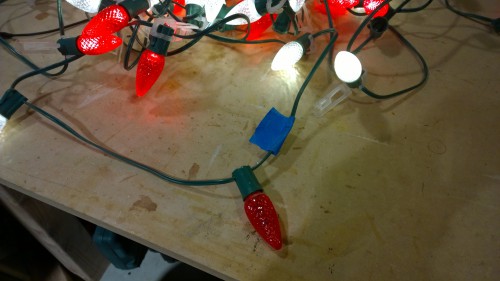 I ordered replacement sockets from Amazon. They come in pretty big quantities, but oh well, this will last me forever and I could use them to create my own custom strands if I wanted to. Make sure that you look to see if your light strand is SPT1 or SPT2. That notation specifies how thick the insulation is on the wire.
I ordered replacement sockets from Amazon. They come in pretty big quantities, but oh well, this will last me forever and I could use them to create my own custom strands if I wanted to. Make sure that you look to see if your light strand is SPT1 or SPT2. That notation specifies how thick the insulation is on the wire.
Doing the replacement is pretty straightforward except that getting the old socket off was tricky. I ended up just cutting and prying away on the old socket until it broke apart. Then I lined up the new socket and clamped it on. As usual, YouTube has a video to explain it.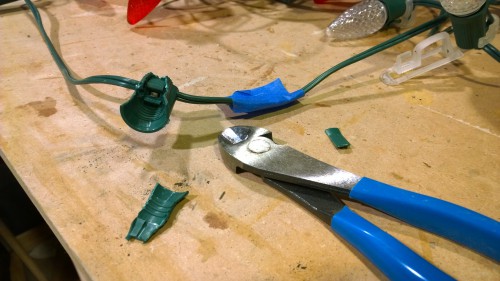 While I was doing all this, I figured I might as well make my strand be exactly the correct length. You can just clip the strand wherever you want and have it keep working, but be sure to clip the two wires at different lengths and then wrap them individually to make sure they don’t short out. Or you can add a new female plug to one end and a male plug to the other and bam, you now have two strings. I chose to add the new plugs. You can buy the male and female plugs on Amazon and learn how to properly install them via YouTube.
While I was doing all this, I figured I might as well make my strand be exactly the correct length. You can just clip the strand wherever you want and have it keep working, but be sure to clip the two wires at different lengths and then wrap them individually to make sure they don’t short out. Or you can add a new female plug to one end and a male plug to the other and bam, you now have two strings. I chose to add the new plugs. You can buy the male and female plugs on Amazon and learn how to properly install them via YouTube.
Sure this is a lot of trouble to go through for Christmas lights, but you know by now that I like things to work properly. This also makes me feel a LOT better about spending extra money on the professional grade lights. Every individual piece of this setup is replaceable. Whether sockets, plugs, bulbs, or even the wires go bad, I can replace just what’s needed. The worst (most expensive) thing that could happen would be if all of the LED bulbs broke but I’m storing them in a hard plastic container to help protect against that. Next year? MORE LIGHTS!
Workbench TV
A lot of my projects have how-to videos on YouTube so it’s not uncommon to have my laptop sitting on the workbench while I work. That’s not terrible, but it would be nicer to have a more permanent installation. After a chat with KenC and some swapping, I ended up with a 32″ LCD. It’s a bit bigger than my initial thought but it ended up working quite well.
He included a mounting bracket with the pile of goodies and since the studs are bare in the garage, mounting was a breeze. The next concern was protecting it a little bit from the saw dust. Using scrap lumber, I whipped up some shelves to cover the top and the sides. They’re not beautiful but I didn’t have to buy anything extra to build them so the price was right.
I’ll have a future blog post with more details but to get content to the TV, I’m going to be using an Amazon Fire TV. For the sound, Ken mentioned that the speakers weren’t great, and indeed, they are not. They would be sufficient for this purpose but I’m going to try to hook up some old computer speakers to the headphone port and see if that sounds better. They can sit right inside the new shelves.
Thanks Ken for helping me upgrade my shop!
Rain
 With all the drainage that we installed in the yard this year, I’ve been wondering how much less water ends up in our yard. Subjectively, it seems like it must be a lot because our yard is usable in the winter now as opposed to the mudhole we used to have. But what’s the actual number?
With all the drainage that we installed in the yard this year, I’ve been wondering how much less water ends up in our yard. Subjectively, it seems like it must be a lot because our yard is usable in the winter now as opposed to the mudhole we used to have. But what’s the actual number?
Our house is 2660 square feet and two floors. If we estimate that it’s split evenly between the floors that’s about a 1300 square feet footprint, or 187,200 square inches. If we get one inch of rain, that’s 187,200 cubic inches or 800 gallons. In November, we got more than 10 inches of rain which means that our roof collected more than enough water to fill the pool at my parents house twice! But there’s more! We also installed French drains in the yard to catch water that runs down the hill into our property and to protect the retaining wall. And we also plumbed the sump pump into the yard drainage so the water that does make it into the crawl space (much less than before!) ends up off our property too.
The bottom line is that yes, adding this drainage is moving a huge amount of water off of our property. If we had more room, it would be cool to collect this in a basin and then pump it back out for irrigation, but we just don’t have the room to make that happen.
DIY Irrigation Winterization
Now that we have an irrigation system, I have one more chore on the fall list: winterization. All the water needs to be blown out of the lines because I sure don’t want to dig them up again! You can pay a company $50-70 to come with a huge generator and blow out all your lines in a matter of minutes. Or you can be a cheapskate like me and do it yourself. I’ll caveat this by saying there a lot of different ways to accomplish this. What you see below is how I chose to do it.
The first piece of the puzzle is an air compressor. The bigger the tank, the better you’ll be. I have an 8 gallon one which is pretty small but worked ok for my yard.
The next challenge was hooking the air compressor up to the irrigation system. When we put it in, Tim installed a quick coupler valve. I went to McClendon’s and built the contraption in the photo below. It’s the quick coupler connector, a ball valve, a reducer and then the quick connect for the air compressor. Shove that into the valve, hook up the air compressor and you’re ready to go.
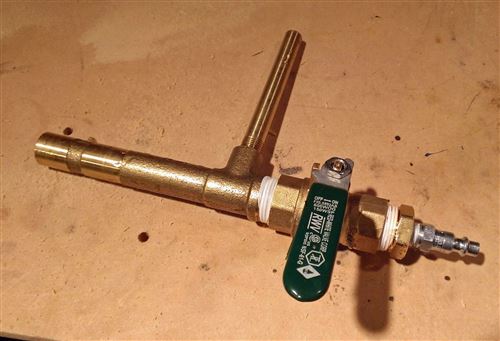
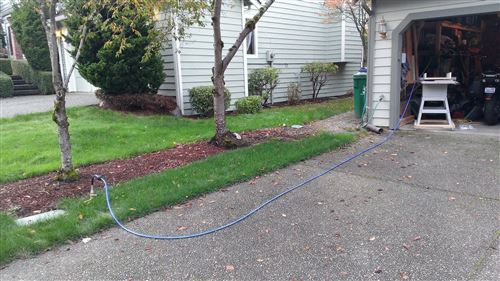
I used a combination of manually opening the valves and using the control clock. The clock kept me drier but the valve box let me be closer to the action to see when I was done. The basic idea is that you pump air into the lines, open up one zone, and let it blow until all the water is gone. The ball valve on the coupler keeps you from getting water pushed back into the air compressor after the first few blows.
Some zones only took a tank or two while others took three or four. This is a two beer job so get comfortable. You don’t want to rush it and leave water in the lines.

